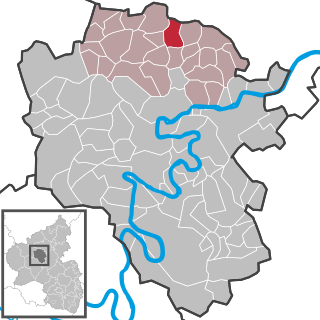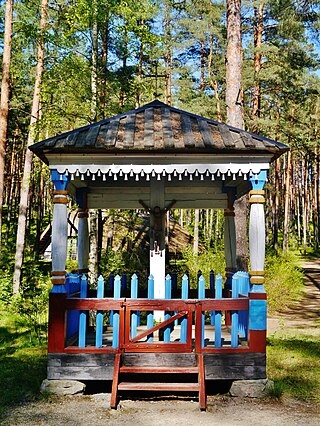
A crucifix is a cross with an image of Jesus on it, as distinct from a bare cross. The representation of Jesus himself on the cross is referred to in English as the corpus. The crucifix emphasizes Jesus' sacrifice, including his death by crucifixion, which Christians believe brought about the redemption of mankind. Most crucifixes portray Jesus on a Latin cross, rather than a Tau cross or a Coptic cross.

Meisburg is an Ortsgemeinde – a municipality belonging to a Verbandsgemeinde, a kind of collective municipality – in the Vulkaneifel district in Rhineland-Palatinate, Germany. It belongs to the Verbandsgemeinde of Daun, whose seat is in the like-named town. In Meisburg, a Moselle Franconian dialect is spoken.

A pectoral cross or pectorale is a cross that is worn on the chest, usually suspended from the neck by a cord or chain. In ancient history and the Middle Ages, pectoral crosses were worn by both clergy and laity. By the Late Middle Ages, the pectoral cross came to be a special indicator of position worn by bishops. In the Roman Catholic Church, the wearing of a pectoral cross remains restricted to popes, cardinals, bishops and abbots. In Eastern Orthodox Church and Byzantine Catholic Churches that follow a Slavic Tradition, priests also wear pectoral crosses, while deacons and minor orders do not. The modern pectoral cross is relatively large, and is different from the small crosses worn on necklaces by many Christians. Most pectoral crosses are made of precious metals and some contain precious or semi-precious gems. Some contain a corpus like a crucifix while others use stylized designs and religious symbols.

Gerolstein is a town in the Vulkaneifel district of Rhineland-Palatinate, Germany. Gerolstein is a local municipality of the Verbandsgemeinde Gerolstein. It has been approved as a Luftkurort.

Kelberg is an Ortsgemeinde – a municipality belonging to a Verbandsgemeinde, a kind of collective municipality – in the Vulkaneifel district in Rhineland-Palatinate, Germany. It belongs to the like-named Verbandsgemeinde, and is home to its seat. Kelberg is a state-recognized climatic spa.

Gamlen is an Ortsgemeinde – a municipality belonging to a Verbandsgemeinde, a kind of collective municipality – in the Cochem-Zell district in Rhineland-Palatinate, Germany. It belongs to the Verbandsgemeinde of Kaisersesch, whose seat is in the like-named town.

Densborn is an Ortsgemeinde – a municipality belonging to a Verbandsgemeinde, a kind of collective municipality – in the Vulkaneifel district in Rhineland-Palatinate, Germany. It belongs to the Verbandsgemeinde of Gerolstein, whose seat is in the like-named town.

Dohm-Lammersdorf is an Ortsgemeinde – a municipality belonging to a Verbandsgemeinde, a kind of collective municipality – in the Vulkaneifel district in Rhineland-Palatinate, Germany. It belongs to the Verbandsgemeinde of Gerolstein, whose seat is in the like-named town.

Hohenfels-Essingen is an Ortsgemeinde – a municipality belonging to a Verbandsgemeinde, a kind of collective municipality – in the Vulkaneifel district in Rhineland-Palatinate, Germany. It belongs to the Verbandsgemeinde of Gerolstein, whose seat is in the like-named town.

Lissendorf is an Ortsgemeinde – a municipality belonging to a Verbandsgemeinde, a kind of collective municipality – in the Vulkaneifel district in Rhineland-Palatinate, Germany. It belongs to the Verbandsgemeinde of Gerolstein, whose seat is in the municipality of Gerolstein.

Oberbettingen is an Ortsgemeinde – a municipality belonging to a Verbandsgemeinde, a kind of collective municipality – in the Vulkaneifel district in Rhineland-Palatinate, Germany. It belongs to the Verbandsgemeinde of Gerolstein, whose seat is in the like-named town.

Pelm is an Ortsgemeinde – a municipality belonging to a Verbandsgemeinde, a kind of collective municipality – in the Vulkaneifel district in Rhineland-Palatinate, Germany. It belongs to the Verbandsgemeinde of Gerolstein, whose seat is in the like-named town.

Rockeskyll is an Ortsgemeinde – a municipality belonging to a Verbandsgemeinde, a kind of collective municipality – in the Vulkaneifel district in Rhineland-Palatinate, Germany. It belongs to the Verbandsgemeinde of Gerolstein, whose seat is in the like-named town.

Stadtkyll is an Ortsgemeinde – a municipality belonging to a Verbandsgemeinde, a kind of collective municipality – in the Vulkaneifel district in Rhineland-Palatinate, Germany. It belongs to the Verbandsgemeinde of Gerolstein, whose seat is in the municipality of Gerolstein. Stadtkyll is a state-recognized climatic spa (Luftkurort).

Steffeln is an Ortsgemeinde – a municipality belonging to a Verbandsgemeinde, a kind of collective municipality – in the Vulkaneifel district in Rhineland-Palatinate, Germany. It belongs to the Verbandsgemeinde of Gerolstein, whose seat is in the municipality of Gerolstein.

A wayside shrine is a religious image, usually in some sort of small shelter, placed by a road or pathway, sometimes in a settlement or at a crossroads, but often in the middle of an empty stretch of country road, or at the top of a hill or mountain. They have been a feature of many cultures, including Chinese folk religious communities, Catholic and Orthodox Europe and some Asian regions.

A summit cross is a Christian cross on the summit of a mountain or hill that marks the top. Often there will be a summit register (Gipfelbuch) at the cross, either in a container or other weatherproof case.

A wayside cross is a cross by a footpath, track or road, at an intersection, along the edge of a field or in a forest. It can be made of wood, stone or metal. Stone crosses may also be conciliation crosses. Often they serve as waymarks for walkers and pilgrims or designate dangerous places.

The basalt cross is a particular type of stone cross found in the Eifel mountains of Germany, bearing witness to the piety of the local population in times past. These crosses indicate their beliefs as well as the wealth and standing of the people who erected them. Details such as accidents, occupations and prayer requests have survived, thanks to the extremely weather-resistant material of which the crosses are made. Their geographic distribution is centred on the basalt quarries of Mayen and Mendig, and covers an area with a radius of approximately 30 kilometres between the Rhine, Ahr and Moselle rivers. The exact number of monuments is not known. Local historian, Kurt Müller-Veltin, estimates that there are about 4,500 wayside crosses and about 6,000 grave crosses. The conservation of these monuments is undertaken by the Rhenisch Society for Monument Conservation.

Stone crosses in Central Europe are usually bulky Christian monuments, some 80–120 cm (31–47 in) high and 40–60 cm (16–24 in) wide, that were almost always hewn from a single block of stone, usually granite, sandstone, limestone or basalt. They are amongst the oldest open-air monuments. A larger variant of the stone cross, with elements of a wayside shrine is called a shaft cross (Schaftkreuz).




















